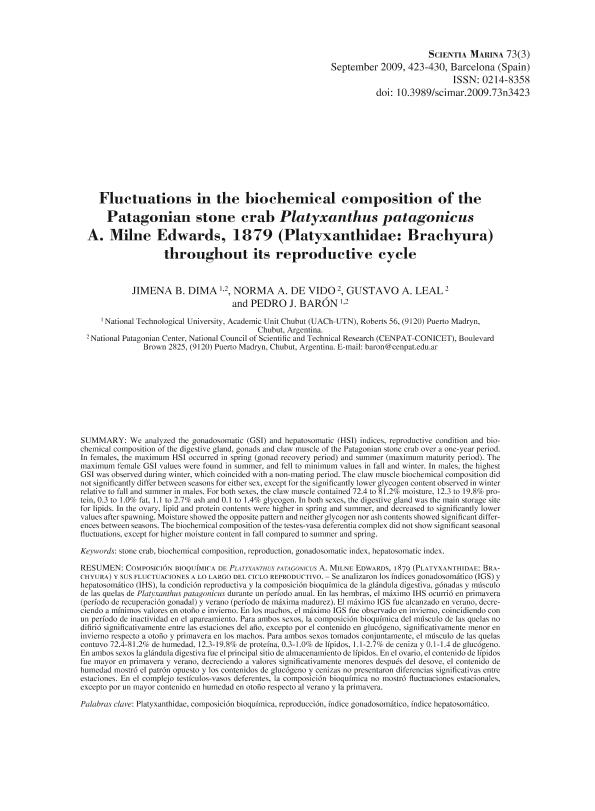Artículo
Se analizaron los índices gonadosomático (IGS) y hepatosomático (IHS), la condición reproductiva y la composición bioquímica de la glándula digestiva, gónadas y músculo de las quelas de Platyxanthus patagonicus durante un período anual. En las hembras, el máximo IHS ocurrió en primavera (período de recuperación gonadal) y verano (período de máxima madurez). El máximo IGS fue alcanzado en verano, decreciendo a mínimos valores en otoño e invierno. En los machos, el máximo IGS fue observado en invierno, coincidiendo con un período de inactividad en el apareamiento. Para ambos sexos, la composición bioquímica del músculo de las quelas no difirió significativamente entre las estaciones del año, excepto por el contenido en glucógeno, significativamente menor en invierno respecto a otoño y primavera en los machos. Para ambos sexos tomados conjuntamente, el músculo de las quelas contuvo 72.4-81.2% de humedad, 12.3-19.8% de proteína, 0.3-1.0% de lípidos, 1.1-2.7% de ceniza y 0.1-1.4 de glucógeno. En ambos sexos la glándula digestiva fue el principal sitio de almacenamiento de lípidos. En el ovario, el contenido de lípidos fue mayor en primavera y verano, decreciendo a valores significativamente menores después del desove, el contenido de humedad mostró el patrón opuesto y los contenidos de glucógeno y cenizas no presentaron diferencias significativas entre estaciones. En el complejo testículos-vasos deferentes, la composición bioquímica no mostró fluctuaciones estacionales, excepto por un mayor contenido en humedad en otoño respecto al verano y la primavera. We analyzed the gonadosomatic (GSI) and hepatosomatic (HSI) indices, reproductive condition and biochemical composition of the digestive gland, gonads and claw muscle of the Patagonian stone crab over a one-year period. In females, the maximum HSI occurred in spring (gonad recovery period) and summer (maximum maturity period). The maximum female GSI values were found in summer, and fell to minimum values in fall and winter. In males, the highest GSI was observed during winter, which coincided with a non-mating period. The claw muscle biochemical composition did not significantly differ between seasons for either sex, except for the significantly lower glycogen content observed in winter relative to fall and summer in males. For both sexes, the claw muscle contained 72.4 to 81.2% moisture, 12.3 to 19.8% protein, 0.3 to 1.0% fat, 1.1 to 2.7% ash and 0.1 to 1.4% glycogen. In both sexes, the digestive gland was the main storage site for lipids. In the ovary, lipid and protein contents were higher in spring and summer, and decreased to significantly lower values after spawning. Moisture showed the opposite pattern and neither glycogen nor ash contents showed significant differences between seasons. The biochemical composition of the testes-vasa deferentia complex did not show significant seasonal fluctuations, except for higher moisture content in fall compared to summer and spring.
Fluctuations in the biochemical composition of the Patagonian stone crab Platyxanthus patagonicus A. Milne Edwards, 1879 (Platyxanthidae: Brachyura) throughout its reproductive cycle
Título:
Composición bioquímica de Platyxanthus patagonicus A. Milne Edwards, 1879 (Platyxanthidae: Brachyura) y sus fluctuaciones a lo largo del ciclo reproductivo
Fecha de publicación:
12/2009
Editorial:
Instituto de Ciencias del Mar Barcelona
Revista:
Scientia Marina
ISSN:
1886-8134
Idioma:
Inglés
Tipo de recurso:
Artículo publicado
Clasificación temática:
Resumen
Archivos asociados
Licencia
Identificadores
Colecciones
Articulos(CCT-CENPAT)
Articulos de CTRO.CIENTIFICO TECNOL.CONICET - CENPAT
Articulos de CTRO.CIENTIFICO TECNOL.CONICET - CENPAT
Citación
Dima, Jimena Bernadette; de Vido, Norma Alicia; Leal, Gustavo Adolfo; Baron, Pedro Jose; Fluctuations in the biochemical composition of the Patagonian stone crab Platyxanthus patagonicus A. Milne Edwards, 1879 (Platyxanthidae: Brachyura) throughout its reproductive cycle; Instituto de Ciencias del Mar Barcelona; Scientia Marina; 73; 3; 12-2009; 423-430
Compartir
Altmétricas




